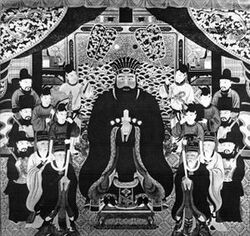Difference between revisions of "Ogo-e"
From SamuraiWiki
Jump to navigationJump to search (Created page with "*''Japanese'': 御後絵 ''(ogoe)'' ''Ogo-e'' (lit. "honorable after-portrait") were posthumous portraits painted of each king of the Ryûkyû Kingdom foll...") |
|||
| Line 1: | Line 1: | ||
| + | [[Image:King Sho En.jpg|right|thumb|250px|''Ogo-e'' of King Shô En.]] | ||
*''Japanese'': 御後絵 ''(ogoe)'' | *''Japanese'': 御後絵 ''(ogoe)'' | ||
Revision as of 17:09, 3 March 2015
- Japanese: 御後絵 (ogoe)
Ogo-e (lit. "honorable after-portrait") were posthumous portraits painted of each king of the Ryûkyû Kingdom following the king's death.
Ten such portraits have been confirmed to have existed, from Shô En through Shô Iku. All were destroyed in the 1945 battle of Okinawa, but pre-war writings indicate they were richly colored, painted in mineral pigments on paper. Today, these portraits survive only in black-and-white photos by Kamakura Yoshitarô. Efforts are being made to reconstruct the techniques or reproduce the portraits.
References
- Plaques on display at Shuri castle.[1]
